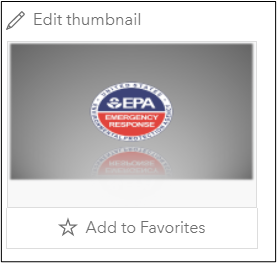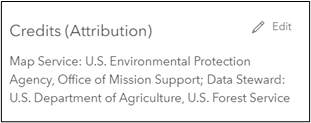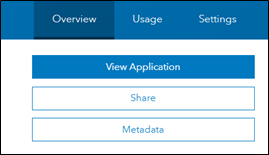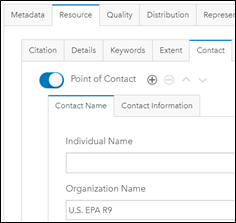Guidance for Content Item Metadata in ArcGIS Online
The EPA Geospatial Advisory Committee (EGAC) provides guidance on the Agency’s Geographic Information System (GIS), which includes the EPA GeoPlatform Online. This interactive platform allows users to create maps, develop applications, and share locational information with EPA stakeholders. The EPA GeoPlatform Online is supported by the Agency’s enterprise licensing agreement with Esri. Detailed instructions on how to use GeoPlatform tools are available on the EPA Geospatial intranet or upon request to the National Geospatial Support Team ([email protected]).
This guidance provides best practices on how to describe geographic information in the GeoPlatform Online, known as content items. Each content item provides developers space to contextualize or describe their data. These descriptions are critical for facilitating the proper use and understanding of data or information by a target audience and are referred to as AGOL service-level metadata. Service-level metadata compliments other forms of geospatial metadata required by Federal Agencies and Departments, including records shared by EPA with data.gov via the EPA Environmental Dataset Gateway.
Service-level metadata and other qualities of content items can be viewed in a content item detail page. This page contains a variety of information, actions, options, and settings organized into the following tabs: Overview, Data, Visualization, Usage, and Settings. These tabs, as well as the options and information available on the tabs, depend on the item type, user privileges, and whether one is an item owner or administrator. To access additional style guides designed specifically for creating metadata for geospatial and non-geospatial data and documenting web services, refer to EPA’s Metadata Style Guide for Geospatial and Non-Geospatial Data.
View Content Item Metadata
To access service-level metadata, click Details under a content item’s thumbnail or, from the gallery, hover over a content item’s thumbnail and click Details. If you own the item, Details can be accessed by clicking the My Content tab on the GeoPlatform’ s primary ribbon. Please note that individual layers in a content item have their own Details pages that pertain to and affect only that sublayer.
Format a Content Item's Title

The Title is the first detail users see when they perform a GeoPlatform search. Users are advised to craft descriptive titles that convey accurate information, including but not limited to geographic location, source, and vintage (date). In terms of format, consistency within and among programs or projects is key and can facilitate data interpretation. As a best practice, titles should be limited to 8 words or fewer. It is generally acceptable to abbreviate terminology that is commonly understood within the EPA (e.g. “RCRA” or “NHD”), but consider spelling out less commonly understood terminology.
As an example, the Agency’s Shared Enterprise Geodata & Services (SEGS) data library uses a hierarchical system to organize program data. Content item titles reflect this structure, where:
CATEGORY – NAME GEOGRAPHIC LOCATION (SOURCE YEAR)
- CATEGORY (required) = SEGS program data category
- NAME (required = a concise descriptive name of the item
- GEOGRAPHIC LOCATION (optional) = extent the data covers (e.g., “Colorado”)
- SOURCE (required) = the originator(s) of the data
- YEAR (optional) = the year associated with the data origination or publication.
These examples are drawn from SEGS:
- AIR – Emissions Inventory System (EPA 2020)
- BND – Oklahoma Statistical Areas (EPA & USCB)
Add a Summary to the Content Item

The Summary is a short description that appears in the results list when searching for GeoPlatform content items. This section should be brief at 1 to 2 sentences, ideally with each no longer than 10 words. The Summary should also be shorter than the Description section but should still provide a user with an accurate depiction of said item. Consider using the following template:
This [region, program office, team] content item depicts [item details] (data type) at [data scale or spatial resolution] for [location or extent ] (date, year, iteration, etc.).
These examples are drawn from SEGS:
- “This SEGS content items depicts public and private K-12 schools in the United States and its territories (points) developed by the USGS's The National Map (2020).”
- “This ORD content items depicts national landcover data at 30-m spatial resolution for the United States and its territories (raster) developed by the Multi-resolution Landcover Consortium in 2021.”
Draft a Detailed Description

The Description provides detailed information on a content item when opened in the GeoPlatform and is the crux of service-level metadata. Users should use this section to thoroughly describe the origin, context, and purpose of a content item, including URLs to relevant information. The Description should be used to provide information and resources beyond what is required by federal metadata standards. It should facilitate appropriate use and interpretation of a given item. At minimum, this section should include a statement on: 1) the data type (points, lines, polygons); 2) brief description of the content; 3) the geographic location; and 4, the data source. It should also include a URL to a corresponding record in the Environmental Dataset Gateway, when appropriate.
The EGAC recommends users deploy paragraph format as broken into two parts. Additional paragraphs may be added if further context or information is needed. An example is provided in the image above and an alternate bulleted below:
- The first paragraph should focus on the program publishing the data, the aim of the program, and program objectives.
- E.g., Shared Enterprise Geodata and Services (SEGS) provides an EPA-curated collection of recommended geodata assets that are nationally relevant and support the Agency’s mission to protect human health and the environment. By connecting EPA users with curated datasets and promoting service reuse, SEGS aims to enhance information access, reduce data-storage costs, and improve the consistency and quality of data at the US EPA.
- The second paragraph provides details on the specific content item, including the business case or content. This can include links to standard operating procedures, acts of legislation, definitions, related datasets, etc. Users should make a best effort to provide the following:
- Scale constraints – E.g., Data are intended to be used at scales of 1:24,000 or smaller.
- Accuracy constraints – E.g., Data were collected with a horizontal accuracy of 30 meters.
- Temporal constraints – E.g., Data represent ground condition on April 24, 1998.
- Other – Retain the originator’s use constraints information (if provided in their metadata or documentation)
- E.g., This SEGS content item depicts county boundaries and/or statistically equivalent entities in the United States and its territories as developed by the U.S. Bureau of the Census in 2019 and minimally enhanced by the EPA to meet Agency needs and use cases. These data were downloaded from the U.S. Bureau of the Census and exclude coastlines.
Position a Thumbnail


The Thumbnail is an image that displays along with the Title and Summary when browsing Content Items in the GeoPlatform. It also appears in galleries, search results, content, and item pages as well. Thumbnails can be created in two ways:
- Upload Image. Users can upload PNG, JPEG, and PNG files to the GeoPlatform as Thumbnails. Esri recommended using an image that is 600 pixels wide by 400 pixels high or larger with an aspect ratio of 3:2 in a web file image format. The PNG format yields the crispest Thumbnails. Images can be resized or clipped in the GeoPlatform. If you add an image in GIF or JPEG format, it will be converted to PNG when it's saved.
- Custom Thumbnail. Users can create a custom Thumbnail by choosing a basemap and setting a map extent of the content item itself. To do this, click ‘Create Thumbnail’ from the map icon in an Item’s Details page. Here, it is recommended users choose a meaningful extent for the content item’s data.
Thumbnails will ideally depict the dataset itself or an image of a program office, as is the case for the Emergency Response (ER) dataset above. It is best practice to display the dataset over a high contrast basemap to facilitate accessibility (typically the Light Grey Canvas basemap). Scale may depend on the interest or performance of the underlying dataset.
Annotate Content Item with Tags

Tags are individual words, short phrases, and abbreviations that describe the content item and facilitate searching in the GeoPlatform. In addition, tags appear as hyperlinks on the Content Item details page. If the hyperlink is selected, users are directed to other items sharing that tag. Separate tags with commas when entering them. For example, ACS Demographics is considered one tag, while ACS, Demographics is considered two tags. Please refer to EPA’s Metadata Style Guide – Keywords and EPA Organization Names for a list of suggested tags (also known as keywords).
Provide Access and Use Constraints

Access and use constraints include all information needed to ensure that the data are being used as intended by the data creator or provider. In October 2021, the Agency adopted an official disclaimer for geospatial data, which is available online. In terms of layout, the Agency advises using the format displayed in the image above. For information on crafting this display, please contact [email protected].
The Agency recommends provides a paragraph that allows data users to contact a given program office with questions, comments, or feedback. This should also include a disclaimer on how to access these data in the GeoPlatform.
If the item has constraints, details must be provided in the Access and Use Constraints text box, ideally in the first descriptive section. Below, these details should be incorporated into the sentence that states: This content item is licensed under the US EPA Data Licensing Agreement for public use. Please reference specific National Archives & Records Administration (NARA) Categories for Controlled Unclassified Information (CUI) as they relate to specific content items.
In general, the following format is recommended:
The Shared Enterprise Geodata and Services (SEGS) team welcomes your feedback. Please submit general comments and questions to the SEGS Shared Mailbox, which is managed by the EPA Office of Mission Support (OMS). Requests for new datasets and related updates should be logged using the SEGS Sharepoint Form. Additional information about this program is available in Microsoft Teams and SEGS services explored using the SEGS Data Discovery Tool.
Please Note: This SEGS content item may require an ArcGIS Online organizational subscription or an ArcGIS Developer account. Please contact the National Geospatial Support Team or an EPA GIS Administrator for assistance accessing the EPA GeoPlatform Online. Public and organizational SEGS services may also be accessed through one of the following actions:
- Sign in with an account that is a member of an organizational subscription.
- Sign in with a developer account.
- Sign in with credentials from an Esri-registered application.
Reference Credits and Collaborators

Credits are acknowledgements of content item creators and providers. Acknowledge all entities that were involved in making the content item available for use. Credits provide users with important information about the origin of the content item.
Public Facing Items: Provide a Point of Contact
All public facing applications are encouraged to identify the source of the data layer. The source serves as the contact for each public facing item. This field should reflect the region or program office in which the point of contact is located.
Edit the resource contact by opening the metadata button. Next navigate to resource then contact. If the radio button is switched off, switch it to on and enter in the program office or region in the Organization Name slot.


Format for Program Offices: U.S. EPA (Program Office Abbreviation)
Format for Regions: U.S. EPA (Regional Abbreviation).
- U.S. EPA OAR
- U.S. EPA OCSPP
- U.S. EPA OCFO
- U.S. EPA OECA
- U.S. EPA OGC
- U.S. EPA OIG
- U.S. EPA R1
- U.S. EPA R2
- U.S. EPA R3
- U.S. EPA R4
- U.S. EPA R5
- U.S. EPA R6
- U.S. EPA R7
- U.S. EPA R8
- U.S. EPA R9
- U.S. EPA R10
- U.S. EPA OITA
- U.S. EPA OLEM
- U.S. EPA OMS
- U.S. EPA ORD
- U.S. EPA OW
Publishing Content from Esri ArcGIS Pro to the GeoPlatform Online
Follow the steps below to ensure all metadata is published to the GeoPlatform Online when sharing from Esri ArcGIS Pro.
- Navigate to the layer properties > metadata.
- Select “Layer has its own metadata” from the dropdown
- Select “Copy data source’s metadata to this layer”
Now, when a layer is published to the GeoPlatform Online using “Share as Web Layer” the metadata will be included in the item.
